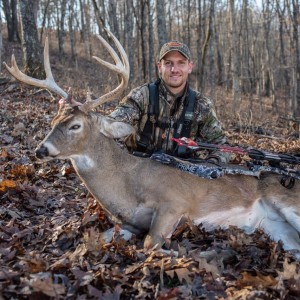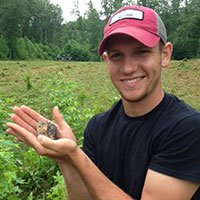LISTEN TO THE PODCAST HERE:
Matt Dye Gearing up

Matt Dye Gearing up. Well, I think a little history, it’s 50 years from the first whitetail hunt I had on the same farm in Wisconsin with Dick Rogers and the family crew there and just hey, thanks Eddie Woolever and all the Shear boys, for just a great 50 years. And folks, that means a lot to me and that’s part of why I’m doing the show just to share that tradition of hunting the same farm for over 50 years.
No, I didn’t hunt it every year for 50 years the last 10 I’ve been hunting it since I retired, but it’s just a magical thing what hunting did in my life and it started with Dick Rogers in 1966. So enough of that, and let’s move on. I don’t mean to minimize that but I better stop. Matt Dye Gearing up
Yeah, that’s really special Bruce, and it’s kind of funny you share that
Matt: Yeah, that’s really special Bruce, and it’s kind of funny you share that because I’m currently, I guess I’m away from the office. I’m in Virginia right now because I’m on vacation, we’re back to see family. Matt Dye Gearing up
I grew up in Virginia, hunted here for 22 years of my life and just driving around and seeing some of the places and the farms that I used to hunt I’m kind of having the same emotions, it’s just that moving away and coming back but it’s sorta nice just to see and know what took place at these farms and all these hunts that I had in the deer woods or turkey wood, it’s just special just to know that I had such an impact on our lives. I think everyone who’s a hunter, whether you’re deer hunter, turkey hunter or waterfowl hunter, you just have those experiences.
I grew up in Virginia, hunted here for 22 years of my life
And getting back to those places it leaves a special mark on our hearts, so.

There’s been research out in Pennsylvania down here recently, based on just GPS collared bucks, and they just tracked the amount of travel that a buck, this actually took place on an individual buck throughout the entire month of October, I believe it was. Or it was during a 30 day period before the rut. I’m not sure of the exact dates.
But it was somewhere within the neighborhood of 24, 25 miles that one of the bucks traveled
But it was somewhere within the neighborhood of 24, 25 miles that one of the bucks traveled. And then they compared that to the next month, or the next 30 days and of course, that correlated with pre-rut, lock-down rut phase, post-rut, everything in that specific region. And that buck traveled three, nearly four times the amount it did the 30 days prior. So as a hunter I’m taking that information and going wow, okay so that deer is on its feet a lot. Three times as much as he is in October.
So that gives me, okay, if I’m in the right place I’m three to four times more likely to intercept him in the right place just during that period because he’s on his feet that much more. Yeah, he’s traveling and covering more ground but deer still have a core area, they still will frequent those places and if you can identify that prior to season or during season if you have encounters with them. Locate a trail, locate a pinch point that that deer’s likely to use in that area and actually your success rate increases because guess what?
I’m three to four times more likely to intercept him in the right place
He’s gonna travel through there and hope it’s during the daylight or hope at the time where the weather conditions will allow you to get in there. But understanding that and realizing that okay, that’s how much more deer travel. Man, that’s just a relief almost, for me, in my head I’m like, okay there’s a chance, there’s an opportunity whether that buck’s been nocturnal the entire month before that whether those 24 miles, 25 miles was all nocturnal doesn’t matter.
He’s going to be traveling more during this next month I’m gonna give it my best, I’m gonna give it the best option I have to intercept that deer and I think this pinch point or close to this area is gonna give me that opportunity.

A lot of that has to do with the local deer herd and the population dynamics within it. So once you’ve worked out the ratio how far they’re traveling to seek receptive does is there a high density of does? Where’s the best cover at? If my property’s got the best security cover and again we kind of talked about this earlier in yesterday’s podcast, but a lot of does are going to be in and around a bedding area during the rut.
but a lot of does are going to be in and around a bedding area during the rut.
It’s secure, they’re tired of bucks chasing them so if I have the best security cover, that means I’m probably going to have a lot of does on my property. Again with another food source though, it’s kind of tight and putting those two together always want food, always want cover, secure cover, and guess what? If I have that secure cover I’m gonna have does I’m gonna have bucks. Especially like I said, this is talking about during the rut. So there’s a lot of different factors that go into it but the local deer herd, what it’s like, what’s the terrain like around your area, as well as the cover that you can provide on your property.
So deer travel, there’s no doubt during the rut. There are some research behind, usually, a lot of bucks will take some mini-excursions if you will, they’ll go outside their home range, their core area, and that’s the thing, that’s what makes each deer an individual. And a lot of it may have to do with a doe. Okay, maybe the doe was close to the edge of her range and she came into heat and that buck was on the edge of his range and he’s like, “That doe’s in heat, I’m chasing her.”
And he’ll take his excrusion and run and chase her a lot, hang with her for a few days, as soon as he breeds her, this is the magic of it, there’s usually in this GPS collar a direct line that buck takes back to get to his core area. He knows that core area, his home range. He knows that area so well, he feels so safe there, once he gets out of it that he’s like “Oh my gosh, I’m nervous, I don’t know the thermals, I don’t know the predators, I don’t know where the deer stands are, I don’t know where hunters usually come in and out of, I’ll go directly back to my core area.”
And it’s basically, it’s almost humorous when you look at GPS [inaudible 00:09:44] data. Because you’ll see it and it’s pretty clear. There’s almost a direct line back to where they know what they know. Those instances happen all the time and I’m not saying that’s what the exact reason is for a buck making an excursion or a buck showing up that you don’t recognize or you don’t know, there’s other reasons for it. But that’s a strong possibility or something that may occur pretty regularly across whitetail’s range.
And that might have been the instance with your friend who shot that 192. Who knows? He could’ve chased a doe in and hung around for a day or two chasing her around and then if he hadn’t had the opportunity to shoot it they’d never have seen that deer again.
Please subscribe, rate and review each @WhitetailRendez podcast at http://getpodcast.reviews/id/1032967565
